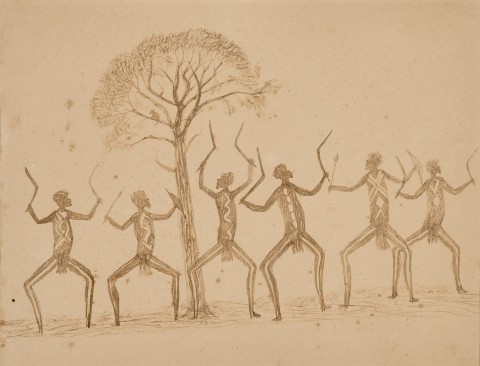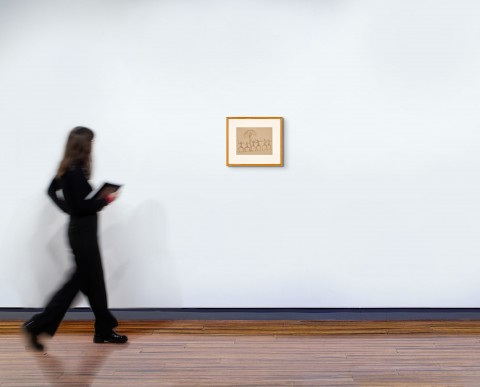WAR DANCE, 1900
TOMMY MCRAE
pen and ink on paper
24.5 x 31.0 cm
bears inscription and date verso: R Kilborn / 1900
George Kilborn, Wahgunyah, Victoria
Thence by descent
Private collection, Melbourne
Joel Fine Art, Melbourne, 3 June 2008, lot 3
Private collection, Sydney
Lachlan War Dance, c.1890, pen and ink on paper, 21.5.0 x 28.0 cm, in the collection of the Latrobe Library, State Library of Victoria, Melbourne, illus. in Sayers, A., Aboriginal Artists of the Nineteenth Century, Oxford University Press, Melbourne, 1994, p. 32, pl. M 14
Tommy McRae, also known as Yackaduna, Warra-euea, Tommy Barnes and Tommy McCrae was born in the 1830s just as the colonisation of the Upper Murray region was commencing. As a young man, McRae experienced the cultural transition from traditional life to one where interactions with settlers became widespread and from the 1850s with the influx of miners following the discovery of gold in the North-east of Victoria, traditional life was overwhelmed by settler culture.
McRae worked for squatters along the Murray River in both New South Wales and Victoria. In his later years he settled at Lake Moodermere south of Wahgunyah on the Victoria side of the Murray River, and it was in these later years that McRae produced his insightful images of both settler life and pre-colonial times. Recording daily events in his community and the emerging towns, his depictions of traditional hunting, fishing, and ceremonial scenes as well as portrayals of settler life and historical events were, perhaps surprisingly, widely admired and supported by the local community. McRae's visual record was a rarity at this time of great change for the local Aboriginal population.
This drawing, acquired by George Kilborn, the youngest son of Roderick Kilborn – McRae’s friend and sometime patron – records an episode in traditional aboriginal life. The subject, a ceremonial war dance, is a theme McRae depicted many times and is almost certainly a recollection of an earlier pre-colonial event. Typical of McRae’s illustrations, the ceremonial dancers are drawn in a row across the page from edge to edge in a frieze-like pattern. The dancers stand, legs wide apart, bent at the knees. All wear a string apron and bear decorative body designs. Each man holds weapons, either a pair of boomerangs or a boomerang and club. The integrated forms of the figures and the movement of the weapons overhead create an effect of dancers moving in complete unison.
The silhouetted images of the dancer are typical of McRae's economy with the pen yet the gesture and movement in his drawings express all that is necessary to convey the story. Tiny details such as the ringtail possum perched on a tree branch observing the events below show as Andrew Sayers observes, that McRae had a ‘keen sense of observation and a characteristic storytelling quality, often showing a wry amusement, combine in his drawings to produce an evocative art, full of vitality.’1
1. Sayers, A., Aboriginal Artists of the Nineteenth Century, Oxford University Press, Melbourne, 1994, p. 49
CRISPIN GUTTERIDGE


